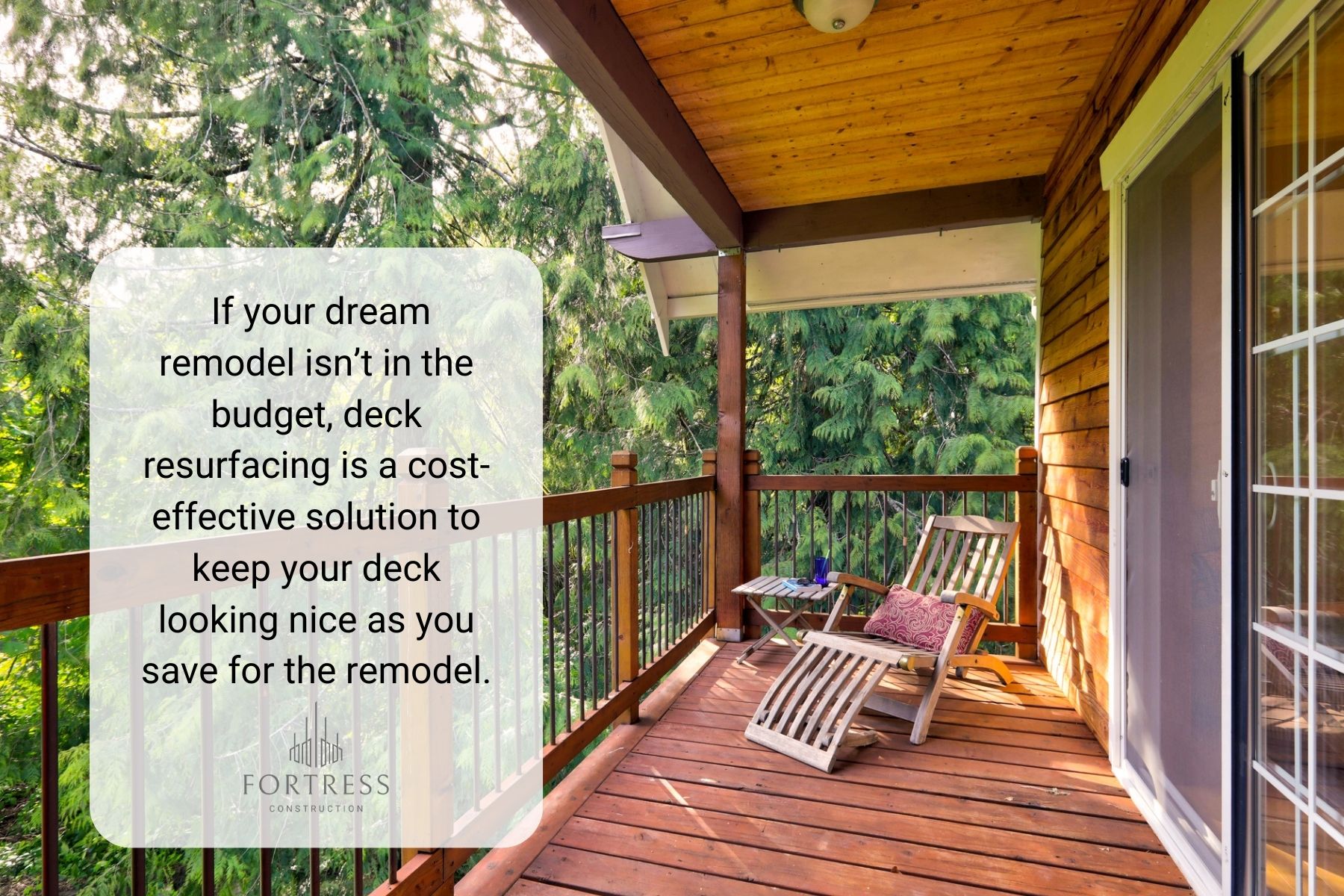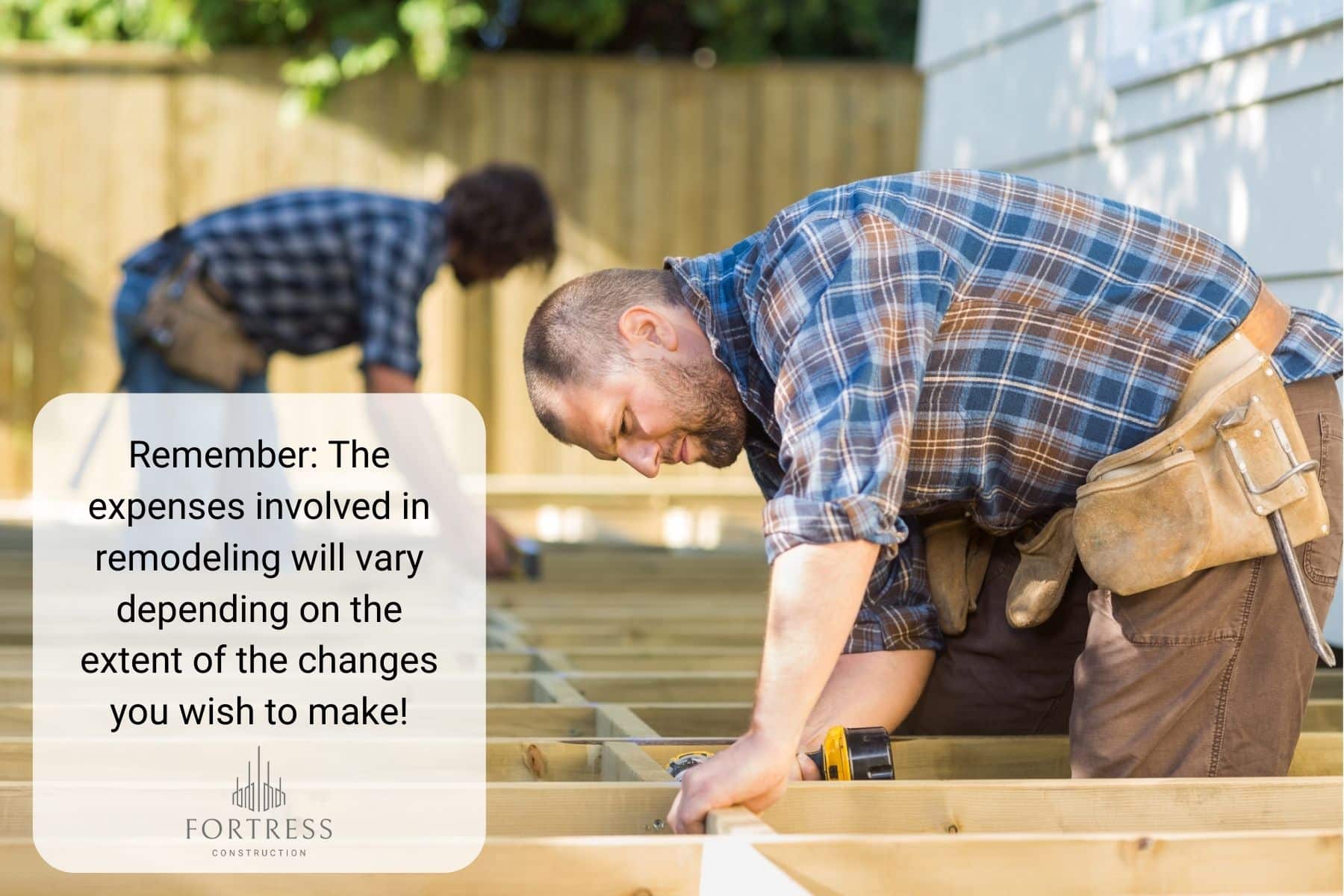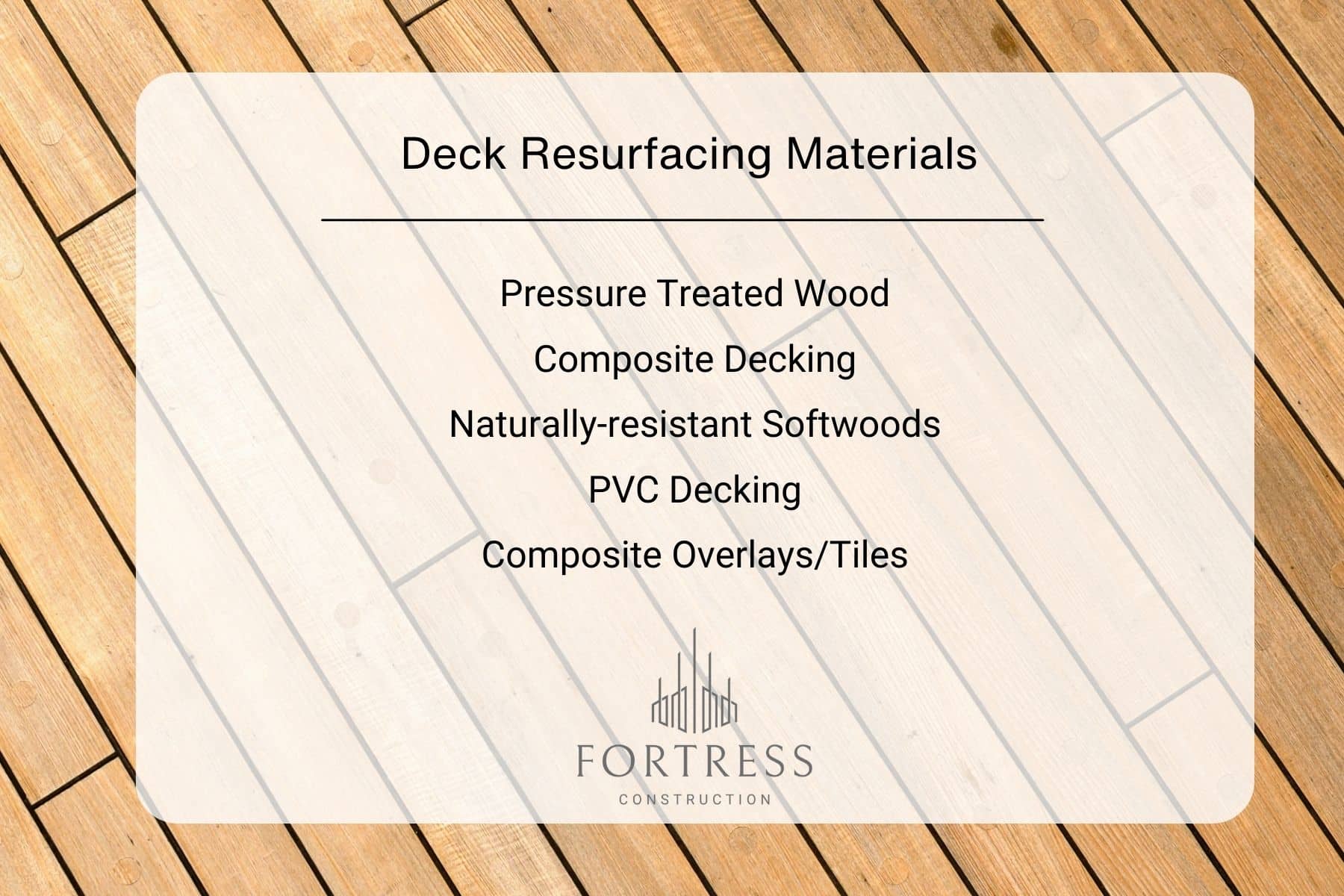Deck Transformation 101: Resurfacing FAQs and Insider Insights
Your deck is the part of your home that blends the indoors with the outdoors. If you’re hosting an event, your deck is a place where guests can go to get a little fresh air. If you need a minute in nature, your deck is a place to sit and enjoy a cup of coffee. And if you’re doing a large, messy project like finger painting with your children or canning tomato juice, there’s no better place to do that than the deck!
But if your deck has seen better days — if it is faded, cracked, bowed, rotting, and greets your bare feet with splinters — it’s time to do something to maintain this core part of your home.
At Fortress Construction, we know that a full deck remodel or replacement isn’t always necessary. Sometimes, all your deck needs is a simple deck resurfacing.
If you’re unfamiliar with deck resurfacing, don’t worry: We’re here to break it down for you!
Table of Contents
What Is Deck Resurfacing?
Deck resurfacing involves keeping the basic structure of your deck but replacing the deck boards, stairs, and/or railings. Sometimes, even if your deck looks terrible, that’s all it needs to be in tip-top shape again!
If your deck boards are in good shape, but you don’t like how they look, deck resurfacing can also involve placing a composite overlay on top of the existing deck boards. Although this type of resurfacing isn’t as long-lasting as completely replacing the deck boards, it’s cheaper and easier to DIY.
Is Deck Resurfacing Worth It?
Deck resurfacing is usually the most cost-effective way to turn an unsightly deck into something you’ll enjoy or use. However, in a few cases, deck resurfacing is not the best option.
1. The deck has underlying structural damage
If the entire structure of your deck is rotting away, resurfacing it is just slapping a bandaid on a gaping wound. Before resurfacing, ask a professional to assess the damage to make sure resurfacing makes sense.
2. You want your deck to look significantly different
If you dream of a bigger deck, a deck in a different location, or other significant changes, it will be more cost-effective in the long run to replace your deck instead of resurfacing it now and completely overhauling it later.
On the other hand, if your dream remodel isn’t in the budget, deck resurfacing is a cost-effective solution to keep your deck looking nice as you save for the remodel.

What’s the Difference Between Resurfacing and Remodeling?
Technically, deck resurfacing is a type of deck remodel. It’s essentially a remodel of the deck’s surface. However, resurfacing does not change the deck's size, shape, or essential features.
You’ll need a more extensive remodel if you want to do any of the following:
- Modify the size or shape of your deck
- Add reinforcement or support
- Add built-in features like benches or planters
When we use the term “remodeling,” we typically refer to a more extensive and expensive process than resurfacing. However, remodeling allows for much more creativity in how the final deck looks.
Should I Resurface, Remodel, or Replace My Deck?
While your deck may only need a surface upgrade, an extensive remodel is sometimes the best option. Other times, you may need to tear down and replace your deck entirely.
When to choose resurfacing
Resurfacing is the best option when the damage is contained to the deck board, railings, and stairs, but the underlying structure is still good. Even if your deck looks terrible, with warped, rotting, or mildewed boards, often a simple resurfacing is all it needs.
When to choose remodeling
With a more extensive deck remodel, you can modify your deck's size, shape, or layout to realize your dream outdoor living space. It’s the best option if your deck is structurally sound, but you dream of something significantly different from what you currently have.
Remember: The expenses involved in remodeling will vary depending on the extent of the changes you wish to make!

When to choose replacing
Sometimes, it’s best to tear down the old deck and start over. If your deck is structurally compromised, if you want your deck to be in a different location, or if you have a completely different deck vision and have the budget to start over, replacement is probably the best option.
When deciding between resurfacing, replacing, or remodeling, here are two additional things to ask yourself:
- What is the future of your deck? Think about how the projects you take on now will affect your future goals. For example, if you dream of putting a hot tub or outdoor kitchen on your deck someday, your deck will need to be able to support the added weight. Keep that in mind as you remodel or replace.
- What do the professionals say? Many builders will give you a free consultation or deck inspection to help you determine what type of repairs make the most sense for your situation.
What Are the Best Deck Resurfacing Materials?
When choosing new deck boards, you have many options depending on your taste and budget! Let’s go over some of them.
- Pressure Treated Wood: This is the most common decking material. It is cost-effective, and since it’s treated with preservatives, it’s resistant to decay, insects, and rot. However, it requires regular maintenance and may warp or splinter over time.
- Composite Decking: Made from a blend of wood fibers and recycled plastics, composite decking is popular for its low maintenance and durability. However, some people prefer a more natural look.
- Naturally-Resistant Softwoods: Some premium softwoods, such as mahogany or cedar, naturally resist decay and insects and have a beautiful color. They’re not the cheapest or most durable option but they offer a gorgeous natural look.
- PVC Decking: This synthetic material will not rot or be eaten by insects, and mold or mildew can be washed immediately. It’s also lightweight and easy to work with. However, not everyone likes the plastic look, and it has fewer color options than composite decking.
- Composite overlays or tiles: If your deck boards are structurally sound and you’re looking for DIY resurfacing, many deck overlays or tiles on the market provide a simple way to upgrade the look of your deck. These overlays are typically made from composite materials that need very little upkeep, but they provide a more temporary solution than replacing the deck boards.

Can I Resurface My Deck Myself?
Many deck projects are completely doable for a home DIY-er, including painting, staining, sealing, and applying composite deck tiles. However, replacing the deck boards is a bit more challenging. If you have carpentry experience and want to take on the task yourself, here are some things to keep in mind:
- Make sure there is no underlying structural damage to your deck. If you have any doubts, call in a professional to assess it!
- Put safety first. Make sure you have safety glasses, gloves, and hearing protection, and take proper precautions when using power tools.
- Do the job thoroughly and correctly. Before you take on the task, ensure you have all the proper tools and know how to use them. Take the time to do the job correctly the first time so you don’t have to deal with expensive fixes down the line.
Remember, if you don’t have carpentry experience, you don’t have the extra time, or you’re unsure if your deck is structurally sound, it’s best to call in a professional!
How Fortress Construction Can Help
At Fortress Construction, we build, remodel, and resurface outdoor living spaces while focusing on quality, integrity, and good customer service.
We also have more articles like this one to help you on your journey if you’re interested in building a patio, want to add a deck to your home, or are looking for design ideas for a new screened-in porch!
Our services include:
- Deck Remodeling and Resurfacing
- New Deck Construction
- Three Seasons Porches
- Screened-in Porches
- Patios and Hardscapes
Ready to get started? Contact us today to get a free estimate or schedule a free consultation!
We can’t wait to hear from you.







